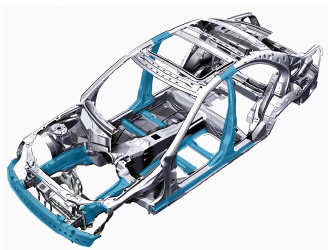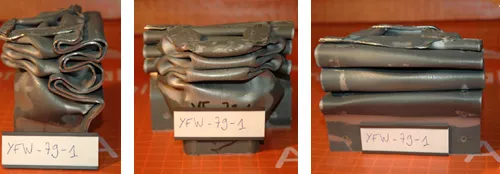Products
Product pages available in
EN - DE - FR - ES
Sustainability
News, events and stories

Daimler becomes one of the first carmakers to start Ductibor® 1000 approval process
Ductibor® 1000 is one of the latest products in ArcelorMittal’s range of press hardenable steels (PHS) for hot stamping. Daimler, a global manufacturer of prestige vehicles, became one of the first carmakers to initiate an approval process for this extraordinary material. Depending on the results of that testing, Ductibor® 1000 may be used to form parts of a new Daimler vehicle.

A generic Daimler body-in-white showing parts which could potentially be formed from Ductibor® 1000
© DaimlerDuctibor® 1000 offers carmakers a unique combination of high strength and good local crash ductility. In terms of mechanical properties, it’s a good fit between Usibor® 1500 and Ductibor® 500 and can be used in the same production processes. “The finely graduated strengths between these three grades allow OEMs to adjust and improve the function of the body-in-white (BIW) while potentially achieving significant weight savings at the same time,” notes Jean-Luc Thirion, head of ArcelorMittal’s Global R&D for Automotive.
Global solution for global carmakers
With ArcelorMittal’s industry leading automotive steels available globally, OEMs can use existing hot stamping lines anywhere in the world. This allows carmakers to develop a vehicle in one location, then serially produce it locally, without major modifications to the local line’s furnaces or tooling. For a global OEM such as Daimler, this is a vital advantage.
Compared to AHSS for cold stamping, Ductibor® 1000 offers better formability and geometric accuracy, a feature of the hot stamping process explains Jean-Luc Thirion: “That enables carmakers to create parts which are not possible with cold stamped AHSS above 800 MPa. There is also less springback.”

Trapezoidal shaped ‘Omega’ sample of Ductibor® 1000 used for crash and bending tests on a deformed product
Ductibor® 1000 can potentially increase the number of press hardened steel (PHS) parts used in today’s vehicles. For example, it could be a solution for energy absorption parts which must safely deform during the crash such as front and rear rails. “Depending on the formability and mechanical properties required for the specific part, Ductibor® 1000 can be an excellent choice,” says Jean-Luc Thirion. “Carmakers also have the possibility of combining Usibor® 1500 and Ductibor® 1000 in laser welded blanks.”

Jean-Luc Thirion, Automotive portfolio leader, ArcelorMittal Global R&D
Optimising lightweighting opportunities
For many OEMs, weight saving potential is a critical assessment criterion when assessing new materials. The high strength of Ductibor® 1000 allows Daimler to minimise the thickness of parts, ensuring the part is significantly lighter. “Ductibor®1000 can also be a substitute for cold forming steels (such as micro-alloyed steels or DP grades) to optimise lightweighting opportunities,” notes Jean-Luc Thirion.
Daimler is assessing Ductibor® 1000 for parts which demand crash robustness at spot welds such as the B-pillar. But it is also suitable for parts which require high levels of local crash ductility such as longitudinal and cross members. Ductibor® 1000 can also be an extremely useful material to lightweight vehicles with a steel intensive or mixed-material body-in-white (BIW).
Two-years of trials and feedback
“Several years before Ductibor® 1000 was commercialised, ArcelorMittal started working with Daimler and other carmakers. They were provided with samples of Ductibor® 1000 and encouraged to do basic testing on the material. As well as helping carmakers to become familiar with the material, the tests helped ArcelorMittal to fine-tune the product and proved that the mechanical concept behind Ductibor® 1000 had advantages. When I couldn’t help, I was able to refer them to one of ArcelorMittal’s many experts who cover various fields such as welding, tensile strength, crash testing, and hydrogen embrittlement testing.
Jérôme Favero, ArcelorMittal’s resident engineer at Daimler

Jérôme Favero, Daimler resident engineer, ArcelorMittal Global R&D
Since Ductibor® 1000 was released at the end of 2017, Daimler has been researching applications for this remarkable material. With the long model development cycles in the industry, it could still be a few years before production vehicles are using the new grade. But thanks to its unique combination of high strength and ductility, and the lightweighting opportunities it offers, there are likely to be some Daimler vehicles using Ductibor® 1000 on our roads.
More info on Ductibor® 1000






